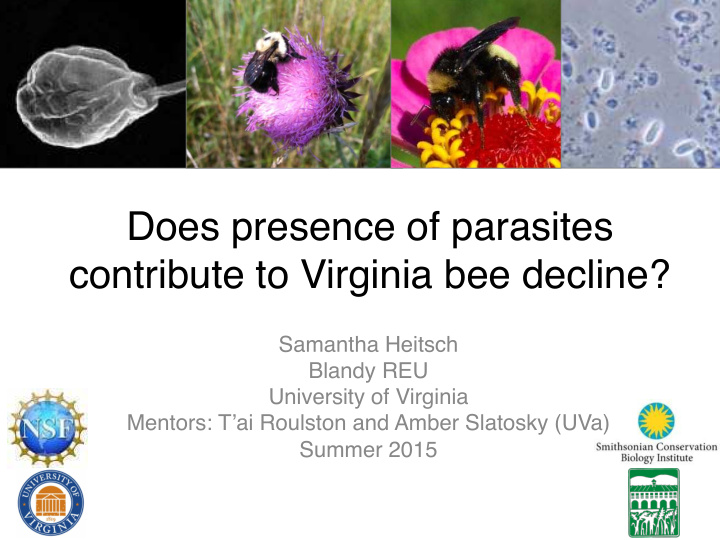



Does presence of parasites contribute to Virginia bee decline? Samantha Heitsch Blandy REU University of Virginia Mentors: T’ai Roulston and Amber Slatosky (UVa) Summer 2015 1"
There are species of bumblebees experiencing serious declines B. occidentalis B. pensylvanicus B. affinis Map adapted from Cameron et al. 2011 2" B. terricola
Relatedness of declining species 3"
Crithidia bombi • Trypanosome • Inhibited colony founding • Reduced colony sizes • Non-lethal effects on workers Nosema bombi • Microsporidian (Kingdom: Fungi) " • Queens stop mating • New queens have lowered colony founding success • Crippled males • Higher mortality • Delayed worker production • Non-lethal effects on workers 4" Brown et al., 2003; Gegear et al., 2006Velthuis & van Doorn, 2006; Otti & Schmid-Hempel 2007 & 2008, Rutrecht & Brown, 2009
Nosema Infection Prevalence across Species 0.4" Propor8on"infected"with" Nosema' 0.35" 0.3" 0.25" 0.2" 0.15" 0.1" 0.05" 0" B."vos" B."bif" B."occ" B."imp" B."bim" B."pen" Species" 5" Based on Cameron et al. 2011
Hypotheses 1. Declining species have a higher incidence of disease than common species at sites where they co-occur. 2. Declining species occur primarily at sites where the incidence of Nosema and Crithidia is low . 6"
The Project 7"
Methods: Field Work • 12 old field and wildflower meadow sites • 6 species • 25 individuals per species 8"
Methods: Lab Work • Housed bumblebees in individual containers with food • Took fecal and tarsal samples • Euthanized bees (deep freeze) • Analyzed samples 9"
Results: Individuals Collected 14" 12" 10" Frequency)of)sites) 8" Sites"over"5" 6" Sites"over"10" 4" 2" 0" B."impa8ens" B."griseocollis" B."fervidus" B."auricomus" B."pensylvanicus" Species) 10"
Results: Crithidia levels Crithidia infection rates did not differ between species (p= 0.298) or sites (p = 0.559). Overall infection rates were 60-80% of individuals per species and per site. 11"
Results: Nosema levels 0.6" Propor2on)infected)with) Nosema ) 0.54" 0.50" 0.5" 0.4" 0.3" Manassas"NBP" Sky"Meadows" 0.2" 0.10" 0.1" 0.00" 0" B."impa8ens" B."pensylvanicus" Species) Significant effect (species) for Nosema infection levels (p < 0.001) 12"
Looking Ahead This coming year: bolstering our sample size to enhance our Nosema infection model Genetic analysis to come! Future work on other factors 13"
Acknowledgements" I"would"like"to"thank"my"mentors,"T’ai"Roulston"and"Amber"Slatosky." • Thanks"to"the"Roulston"lab"for"all"their"help,"in"the"field"and"in"the"lab" • (Rosemary"Malfi,"Umer"Sheikh,"M’Shae"Alderman,"and"Chynna"Taylor)" Thanks"to"Celia"Vuocolo"and"all"the"SCBI,"GMU"and"VWL"researchers"and" • ci8zen"scien8sts." • I would especially like to thank NSF for granting this REU to exist and for supporting our research, as well as the Blandy community for providing us with such a great home this summer. Many"thanks"go"to"the"generous"donors"to"the"College"Science"Scholars" • program"who"make"these"summer"research"awards"possible:"Charles" Henry"Leach,"II,"Founda8on,"Mr."Steve"Van"Besien;"En8gence"Corpora8on;" Lois"A."Fi^on"&"W."Christopher"Draper,"Jr.;"Sharon"B."Parente"&"John"W." Risner;"The"Jefferson"Trust;"Robert"Atkinson;"Lowe"Family;"Dean’s" discre8onary"gics 14"
15"
Recommend
More recommend